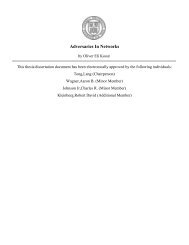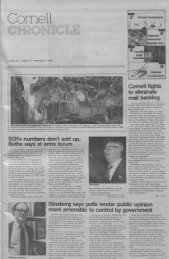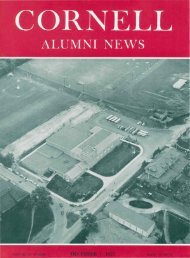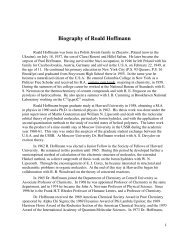Preliminary pages FINAL.pdf - eCommons@Cornell - Cornell ...
Preliminary pages FINAL.pdf - eCommons@Cornell - Cornell ...
Preliminary pages FINAL.pdf - eCommons@Cornell - Cornell ...
You also want an ePaper? Increase the reach of your titles
YUMPU automatically turns print PDFs into web optimized ePapers that Google loves.
ut also the answers that will result. These, and other nuts-and-bolts issues, are taken<br />
up in Chapter 1.<br />
The main body of the dissertation, however, is concerned with linking the<br />
sounds listeners perceive with the nature of singing as a physical activity that relies on<br />
a set of skills. Whereas many academic studies of recordings are organized around<br />
contemporaneous writings on performance practices or musical meaning, this one is<br />
not. 6 Instead, I seek to add to these by proceeding from the assumption that<br />
performance style is a reflection of what performers do, and to describe it as such.<br />
This is the goal of Chapter 2, which argues that much of what we call style actually<br />
has its roots in a singer’s technical habits.<br />
Armed with a vocabulary that interrelates vocalism and style, we turn to the<br />
question of what a recording represents – specifically, to the ways in which a<br />
recording represents the performer. Can we say that a recording represents anything<br />
beyond what a couple of musicians did with a particular piece in a particular studio on<br />
a particular day? To answer this question, we must ask several others. How does<br />
aging affect style? To what degree are performers affected by changing aesthetics<br />
over the course of a long career? How consistently might a performer make certain<br />
style gestures? Questions like these become important when we compare many<br />
singers’ recordings of a single work: to ensure our comparisons are accurate, we must<br />
first know what we are comparing. I address these issues through three case studies,<br />
which comprise Chapter 3.<br />
These two frameworks – a better understanding of how singing and style are<br />
related, and a sense of how a singer’s art may or may not change over time – position<br />
6 Other scholars have spoken to the need for performance studies that proceed from performances rather<br />
than documents; in particular, see Joel Lester, “Performance and Analysis: Interaction and<br />
Interpretation,” in The Practice of Performance: Studies in Musical Interpretation, edited by John Rink<br />
(Cambridge: Cambridge University Press, 1995): 197-216, and Daniel Barolsky, “The Performer as<br />
Analyst,” in Music Theory Online: A Journal of Criticism, Commentary, Research and Scholarship<br />
13/1 (March 2007).<br />
xxv
















